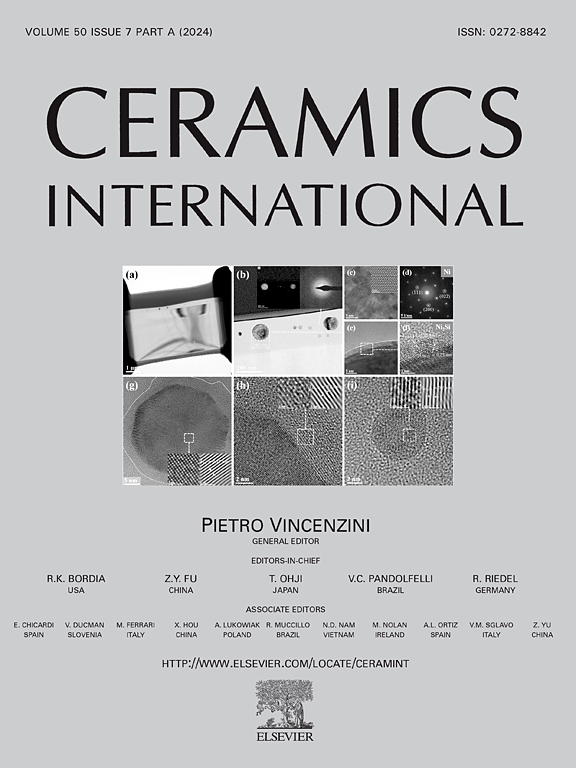Influence of Fe substitution at Al-site on the microstructure and thermophysical properties of garnet-type (Y0.4Er0.6)3Al5O12 ceramics
IF 5.6
2区 材料科学
Q1 MATERIALS SCIENCE, CERAMICS
引用次数: 0
Abstract
In this study, a series of (Y0.4Er0.6)3(Al1-xFex)5O12 (x = 0, 0.2, 0.4, 0.6, 0.8 and 1.0) ceramics were prepared by solid phase synthesis. The effects of Fe doping on the phase structure, lattice occupancy, Raman shift, ionic valence state, micromorphology and thermophysical properties of the ceramics were systematically investigated. The results show that all the (Y0.4Er0.6)3(Al1-xFex)5O12 ceramics exhibit a single Y3Al5O12 phase and the valence state of iron is +3. With the increase of Fe doping concentration, both the lattice constant and cell volume gradually expand, which is attributed to the substitution of Al3+ (smaller ionic radius) by Fe3+ (larger ionic radius). This substitution induces lattice distortion that accelerates the sintering process, resulting in an increase in both ceramic density and grain size. In terms of thermophysical properties, significant improvements were observed compared to pure Y3Al5O12 and (Y0.4Er0.6)3Al5O12 ceramics. Specifically, thermal conductivity decreases, and the thermal expansion coefficient increases with higher Fe doping levels. The (Y0.4Er0.6)3(Al0.2Fe0.8)5O12 ceramic exhibits the lowest thermal conductivity (1.31 W/m·K at 1100 °C), approximately 11.5 % lower than that of (Y0.4Er0.6)3Al5O12 (1.48 W/m·K at 1100 °C). Additionally, (Y0.4Er0.6)3Fe5O12 ceramic demonstrates the highest coefficient of thermal expansion (11 × 10−6 K−1 at 1200 °C), which is around 36.3 % greater than that of (Y0.4Er0.6)3Al5O12 (8.07 × 10−6 K−1 at 1200 °C).
al位Fe取代对石榴石型(Y0.4Er0.6)3Al5O12陶瓷微观结构和热物理性能的影响
本研究采用固相合成法制备了一系列(Y0.4Er0.6)3(Al1-xFex) 5012 (x = 0、0.2、0.4、0.6、0.8和1.0)陶瓷。系统地研究了Fe掺杂对陶瓷的相结构、晶格占位、拉曼位移、离子价态、微观形貌和热物理性能的影响。结果表明:(Y0.4Er0.6)3(Al1-xFex)5O12陶瓷均呈现单一的Y3Al5O12相,铁的价态为+3;随着Fe掺杂浓度的增加,晶格常数和胞体体积都逐渐增大,这是由于离子半径较大的Fe3+取代了离子半径较小的Al3+。这种取代引起晶格畸变,加速烧结过程,导致陶瓷密度和晶粒尺寸的增加。在热物理性能方面,与纯Y3Al5O12和(Y0.4Er0.6)3Al5O12陶瓷相比,有了显著的改善。具体来说,随着Fe掺杂水平的增加,热导率降低,热膨胀系数增大。(Y0.4Er0.6)3(Al0.2Fe0.8) 50o12陶瓷的导热系数最低(1100℃时为1.31 W/m·K),比(Y0.4Er0.6) 3al50o12(1100℃时为1.48 W/m·K)低约11.5%。此外,(Y0.4Er0.6)3Fe5O12陶瓷表现出最高的热膨胀系数(1200℃时为11 × 10−6 K−1),比(Y0.4Er0.6)3Al5O12(1200℃时为8.07 × 10−6 K−1)高36.3%左右。
本文章由计算机程序翻译,如有差异,请以英文原文为准。
求助全文
约1分钟内获得全文
求助全文
来源期刊

Ceramics International
工程技术-材料科学:硅酸盐
CiteScore
9.40
自引率
15.40%
发文量
4558
审稿时长
25 days
期刊介绍:
Ceramics International covers the science of advanced ceramic materials. The journal encourages contributions that demonstrate how an understanding of the basic chemical and physical phenomena may direct materials design and stimulate ideas for new or improved processing techniques, in order to obtain materials with desired structural features and properties.
Ceramics International covers oxide and non-oxide ceramics, functional glasses, glass ceramics, amorphous inorganic non-metallic materials (and their combinations with metal and organic materials), in the form of particulates, dense or porous bodies, thin/thick films and laminated, graded and composite structures. Process related topics such as ceramic-ceramic joints or joining ceramics with dissimilar materials, as well as surface finishing and conditioning are also covered. Besides traditional processing techniques, manufacturing routes of interest include innovative procedures benefiting from externally applied stresses, electromagnetic fields and energetic beams, as well as top-down and self-assembly nanotechnology approaches. In addition, the journal welcomes submissions on bio-inspired and bio-enabled materials designs, experimentally validated multi scale modelling and simulation for materials design, and the use of the most advanced chemical and physical characterization techniques of structure, properties and behaviour.
Technologically relevant low-dimensional systems are a particular focus of Ceramics International. These include 0, 1 and 2-D nanomaterials (also covering CNTs, graphene and related materials, and diamond-like carbons), their nanocomposites, as well as nano-hybrids and hierarchical multifunctional nanostructures that might integrate molecular, biological and electronic components.
 求助内容:
求助内容: 应助结果提醒方式:
应助结果提醒方式:


